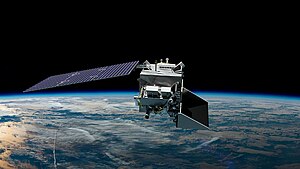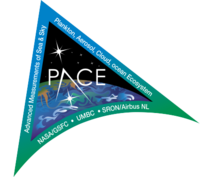
Back Plankton, Aerosol, Cloud, ocean Ecosystem German پلانکتون، آئروسل، ابر، اکوسیستم اقیانوس Persian PACE (satellite) French PACE Latvian/Lettish
 An artist's concept of NASA's PACE spacecraft in orbit. | |
| Names | Pre-Aerosol, Cloud, and ocean Ecosystem PACE |
|---|---|
| Mission type | Remote sensing |
| Operator | NASA |
| COSPAR ID | 2024-025A |
| SATCAT no. | 58928 |
| Website | pace |
| Mission duration | 3-10 years (planned) 4 months, 27 days (in progress) |
| Spacecraft properties | |
| Spacecraft | PACE |
| Manufacturer | Goddard Space Flight Center |
| Launch mass | 1694 kg |
| Dimensions | 1.5 x 1.5 x 3.2 meters |
| Power | 1000 watts |
| Start of mission | |
| Launch date | 8 February 2024, 06:33 UTC [1] [2] |
| Rocket | Falcon 9 Block 5 |
| Launch site | Cape Canaveral, SLC-40 |
| Contractor | SpaceX |
| Orbital parameters | |
| Reference system | Geocentric orbit (planned) |
| Regime | Sun-synchronous orbit |
| Altitude | 676.5 km |
| Inclination | 98.0° |
| Period | 2-day global coverage 60° instrument view angle |
| Transponders | |
| Band | S-Band - Command & Telemetry Ka-Band - Science Data |
| Instruments | |
| Ocean Color Instrument (OCI) Spectro-Polarimeter for Planetary Exploration (SPEXone) Hyper-Angular Rainbow Polarimeter #2 (HARP2) | |
 PACE mission logo | |
Plankton, Aerosol, Cloud, ocean Ecosystem (PACE) is a NASA Earth-observing satellite mission that will continue and advance observations of global ocean color, biogeochemistry, and ecology, as well as the carbon cycle, aerosols and clouds.[3] PACE will be used to identify the extent and duration of phytoplankton blooms and improve understanding of air quality.[4] These and other uses of PACE data will benefit the economy and society, especially sectors that rely on water quality, fisheries and food security.[5]
After being proposed for cancellation under President Trump's FY 2018 budget, it was restored by Congress.[6] The PACE project is managed by NASA Goddard Space Flight Center.[7] The main instrument and bus were designed and built at Goddard Space Flight Center.[8]
On 4 February 2020, NASA announced the selection of SpaceX to launch PACE on a Falcon 9, at a total cost to NASA of US$80.4 million, including the launch service and other mission-related costs.[9] The total cost of the mission is $964 million, which includes spacecraft construction, launch, and operations.[10] PACE successfully launched on 8 February 2024 at 06:33 UTC.[11] On 17 April 2024 it was announced that first operational data was received.[12]
- ^ "SpaceX launches NASA's PACE satellite to study Earth's oceans, air and climate". 8 February 2024. Retrieved 8 February 2024.
- ^ "Liftoff! NASA's Earth Science Mission Launches Into Space Coast Sky". NASA (Press release). 8 February 2024. Retrieved 8 February 2024.
- ^ "PACE". NASA. Retrieved 15 March 2021.
 This article incorporates text from this source, which is in the public domain.
This article incorporates text from this source, which is in the public domain.
- ^ "IOCCG News February 2021". IOCCG. February 2021. Retrieved 15 March 2015.
- ^ Foust, Jeff (24 May 2018). "Bridenstine offers senators reassurances on NASA programs". SpaceNews. Retrieved 15 March 2021.
- ^ Foust, Jeff (22 March 2018). "NASA receives US$20.7 billion in omnibus appropriations bill". SpaceNews. Retrieved 15 March 2021.
- ^ "New NASA Mission to Study Ocean Color, Airborne Particles and Clouds". 13 March 2015. Retrieved 15 March 2021.
 This article incorporates text from this source, which is in the public domain.
This article incorporates text from this source, which is in the public domain.
- ^ "NASA's PACE Mission Will Uncover New Information About Health of Our Oceans". NASA. 20 July 2016. Retrieved 15 March 2021.
 This article incorporates text from this source, which is in the public domain.
This article incorporates text from this source, which is in the public domain.
- ^ Clark, Stephen (5 February 2020). "SpaceX wins contract to launch NASA's PACE Earth science mission". Spaceflight Now. Retrieved 15 March 2021.
- ^ Cite error: The named reference
arswas invoked but never defined (see the help page). - ^ "NASA Invites Media to Launch of New Mission to Study Oceans, Clouds". NASA (Press release). 11 December 2023. Retrieved 11 December 2023.
- ^ "NASA's Near Space Network Enables PACE Climate Mission to 'Phone Home' - NASA". 17 April 2024. Retrieved 18 April 2024.